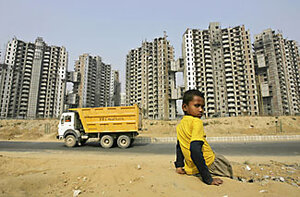Historic buildings lost to India's urban boom
The Lal Mahal – India's oldest surviving Islamic palace – was demolished earlier this month, despite some efforts to better promote preservation.

Housing needs: A boy sat last week on the edge of a residential complex under construction in Gurgaon, India.
Gurinder Osan/AP
New Delhi
Hidden behind the concrete sprawl of a prosperous New Delhi neighborhood, the Lal Mahal or "red palace" attracted few visitors. Guidebooks neglected to mention that this crumbling sandstone building was India's oldest surviving Islamic palace.
Then, on Nov. 1, within a few hours, the 800-year-old structure was demolished by a private developer. Horrified conservationists complained to the city authorities, but there was little they could do: The Lal Mahal was not on the government's list of protected buildings.
This is a depressingly familiar story in India, where only a fraction of historic buildings are protected by law. And as millions of people move from the countryside to India's cities, cash-hungry property developers are tempted to demolish whatever stands in their way.
The Archaeological Survey of India (ASI), a government body, has a list of more than 3,600 protected monuments that it must protect and conserve.
But the Indian National Trust for Art and Cultural Heritage (INTACH), a nongovernmental, nonprofit organization, says there are at least 70,000 old buildings and monuments that should be granted government protection.
"The Lal Mahal was certainly one of them," says O.P. Jain, a leading conservationist. "It's terrible that this should be allowed to happen to a building of national importance."
He points out that even those buildings that are theoretically guaranteed government protection are at risk.
Last year, India's culture and tourism ministry was forced to admit that 35 of the buildings on the ASI's list had been destroyed. Twelve of them disappeared within a few miles of the ministry in New Delhi, among them a magnificent city gate built by the 16th-century ruler Sher Shah.
A dozen more monuments in New Delhi, said the ministry, had been ruined by the encroachment of developers. Legislation passed in 1992 forbids construction within 100 meters (328 feet) of protected buildings. But the law is only patchily enforced.
The survival of India's unlisted buildings, meanwhile, may only be a question of time.
"There are two big problems: the way protected monuments are cared for, and the fact that there are many, many buildings that simply aren't listed at all," says historian and writer William Dalrymple.
In the two decades that he has lived in New Delhi he's seen many old buildings disappear. He cites Old Delhi – the 17th-century city built by the Mughal emperor Shah Jahan – where, "there are hardly any of the old houses left."
The pace of obliteration is quickening as India struggles to cope with the mass movement of migrants from the countryside to the cities.
By 2030, India's urban population is expected to have swelled from 285 million to 575 million.
Take New Delhi, a city dotted with remnants of its invaders, from the Muslim emperors who ruled it for more than 500 years to the British colonialists who followed.
"Surely, in no city on earth – not even Rome itself – are linked memories of bygone dynasties so thick as here," wrote a traveling German soldier, Count Hans von Koenigsmarck, in 1910.
But today, the half million new inhabitants that relocate to the city every year are also leaving their mark. Mughal ruins stand forlornly in the middle of busy roundabouts, or are used as garbage dumps and urinals, while several elegant bungalows built by British architect Edwin Lutyens may soon be demolished.
"This is isn't a concern limited to New Delhi," says the ASI's director general, Anshu Vaish, when asked about the fate of the Lal Mahal. "It is something that happens all over the world, where there's urbanization and commercialization."
Furthermore, in this city of 15 million people, nearly half of whom live in slums, without proper sanitation, some say city authorities have more pressing priorities than conserving old buildings.
Conservationists like Mr. Jain, however, say that the authorities do not have to choose between preservation and development.
Indeed, especially in New Delhi, the government recognizes the importance of historical monuments for the city's global standing. Ahead of the Commonwealth Games, which the city is to host in 2010, New Delhi is planning a clean up of its most famous heritage buildings.
In 2003, Humayun's Tomb, the bulbous-domed 16th-century precursor to the Taj Mahal – which attracts hordes of tourists every year – was given a $650,000 cleanup. Only yards away, the Lal Mahal, built three centuries earlier, would have drawn foreign tourists, prepared to pay high entry fees – if only it had been given the recognition it deserved, says Mr. Jain.
He hopes that a new list of protected monuments, currently being drawn up by INTACH will make it harder for developers to take advantage of India's inadequate conservation efforts.
"But we also have to educate people, tell them that India's past heritage – as well as its future – has great value."
